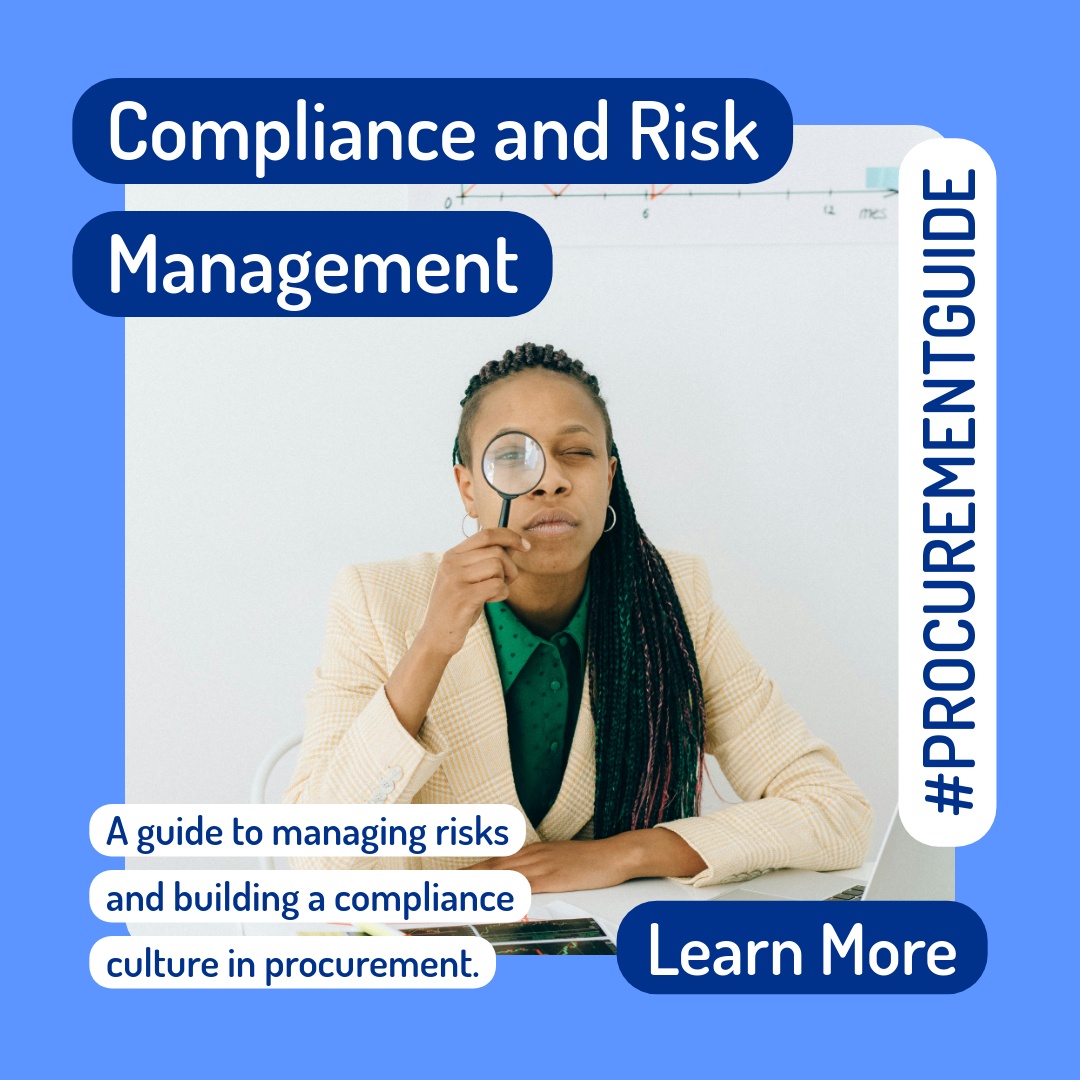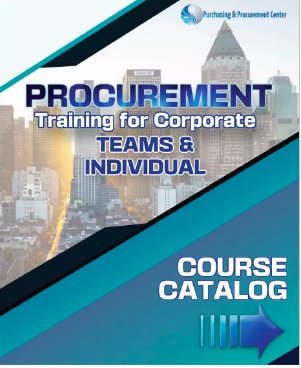Compliance and Risk Management:
Risks, Best Practices, and How to Build a Culture of Risk Awareness
Compliance and Risk Management Summary:
1. 5 Risks Procurement Executives Face
2. Best Practices for Risk Management in Procurement
3. Role of Technology in Enhancing Compliance and Risk Management
4. 4 Ways to Build a Culture of Compliance and Risk Awareness
5. 5 Future Changes to Expect in Procurement Compliance and Risk Management

Compliance and risk management are of critical importance in the fast-paced world of procurement today.
These two elements not only safeguard your organization from legal repercussions but also ensure operational efficiency and reputation integrity.
This guide explores the dynamic role of compliance and risk management in procurement, offering insights into the risks faced by executives, best practices for managing these risks, and how to build a culture of compliance and risk awareness.
You Might Like: Compliance and Risk Management Explained
5 Risks Procurement Executives Face
Procurement processes are inherently susceptible to various risks. Here are 5 of the most common challenges you encounter:
Risk 1- Non-compliance:
Failure to adhere to internal policies, industry regulations, or government laws can lead to hefty fines, project delays, and reputational damage.
Risk 2- Fraud and corruption:
Procurement fraud is a significant concern, with unethical vendors or internal collusion potentially causing financial losses.
Risk 3- Supply chain disruptions:
Global events, natural disasters, or supplier issues can disrupt the flow of goods and services, impacting project timelines and budgets.
Risk 4- Vendor quality issues:
Poor-quality products or delayed deliveries from vendors can compromise project deliverables and customer satisfaction.
Risk 5- Data security breaches:
Procurement often involves sensitive data exchange, making you vulnerable to cyberattacks and data leaks.
Best Practices for Risk Management in Procurement
Effective risk management is vital in procurement to mitigate potential threats and ensure operational resilience. Here are 5 essential best practices you can adopt to enhance your risk management strategies:
1. Take Part in Training and Development:
- Regular training for your procurement staff on risk awareness, mitigation strategies, and regulatory changes ensures everyone is equipped to manage risks effectively.
Check Out: CIPP/CIPM Online Procurement Certification
2. Perform a Comprehensive Risk Assessment:
- Begin with a thorough identification of risks associated with suppliers, market conditions, regulatory changes, and internal processes.
- Risk assessments should not be a one-time activity. Regular updates are necessary to reflect changing conditions and new emerging risks.
3. Conduct Strategic Supplier Selection and Management:
- Conduct extensive due diligence on potential suppliers. This includes assessing their financial stability, compliance with industry standards, and reputation.
- Avoid over-reliance on a single supplier. Diversifying your supplier base can reduce the risk of major disruptions.
- Perform regular audits to ensure internal and external compliance throughout the supply chain.
4. Build Partnerships with Suppliers:
- Build strong relationships with suppliers through regular communication and collaboration. This can lead to better service and quicker resolution of issues.
5. Implement Robust Contract Management:
- Ensure contracts are clear and contain stipulations for compliance, quality standards, and penalties for non-compliance.
- Include clauses that allow for adjustments as circumstances change, such as scaling orders up or down based on demand fluctuations.
- Develop a mechanism for monitoring compliance with contract terms and for enforcing them when necessary.
Role of Technology in Enhancing Compliance and Risk Management
Technology plays a pivotal role in streamlining compliance and risk management within the procurement process. Here's how:
- Technology automates tasks like purchase requisitions, vendor onboarding, and contract management, reducing human error and ensuring adherence to established procedures.
- It provides tools for risk identification, assessment, and mitigation, offering data-driven insights for informed decision-making.
- Allows analyzing procurement data to identify trends, predict risks, and monitor supplier performance.
- Enables centralizing procurement data in a secure and accessible location, facilitating collaboration and audit trails for compliance purposes.
By leveraging these technological advancements, you can gain valuable insights, improve process efficiency, and ultimately enhance their risk management capabilities.
Check Out: Big Data Analytics for Supply Chain & Procurement Training!
4 Ways to Build a Culture of Compliance and Risk Awareness
Creating a culture of compliance and risk awareness within the procurement department is crucial for your long-term success. Here are 4 ways you can achieve this:
1. Provide regular training programs:
Educate employees on relevant regulations, internal policies, and best practices for procurement by enrolling them in trainings and certification programs.
2. Empower employees to speak up:
Foster an environment where employees feel comfortable reporting suspected non-compliance or unethical behavior.
3. Implement a system of accountability:
Hold employees accountable for adhering to established procedures and risk management protocols.
4. Lead by example:
You must demonstrate a strong commitment to compliance and risk management through their own actions and decision-making.
5 Future Changes to Expect in Procurement Compliance and Risk Management
As we look towards the future, compliance and risk management in procurement are poised to evolve dramatically. Here are 5 things you can expect:
1. Rising Value of Procurement Training and Certification Programs:
There will be an increased emphasis on building a culture of risk awareness and compliance throughout your organization. Training programs and certifications will ensure that all employees are informed and vigilant about potential risks.
2. Increased Regulatory Complexity:
Your procurement teams will need to navigate a myriad of rules across different markets, focusing on everything from anti-corruption laws to environmental regulations.
3. Greater Emphasis on Sustainability and Social Responsibility:
There will be a stronger focus on sustainable procurement practices, including the ethical sourcing of goods and services. This shift is driven by consumer demand and regulatory pressures.
4. Advancement of Technology and Automation:
Artificial intelligence (AI) and machine learning will further enhance risk management capabilities in procurement to predict potential disruptions, analyze supplier risk profiles, and automate complex compliance processes.
5. Enhanced Collaboration Across Departments:
There will be a move towards more integrated risk management approaches, where procurement, finance, and compliance departments work closely to manage risks holistically across your enterprise.
Master Over 95% Procurement Skills

As we've seen, compliance and risk management are not just regulatory requirements but strategic elements crucial for the success and sustainability of any procurement operation.
You must embrace these practices, leverage technology, and foster a culture of awareness to navigate the complexities of the modern business environment successfully.
By doing so, you will not only protect your organization but also drive towards greater procurement efficiency and success in the future.
Interested in specializing in over 95% of practical procurement skills? Explore our 30+ training programs led by expert instructors!
Get Back From Compliance and Risk Management to Supplier Risk Management


